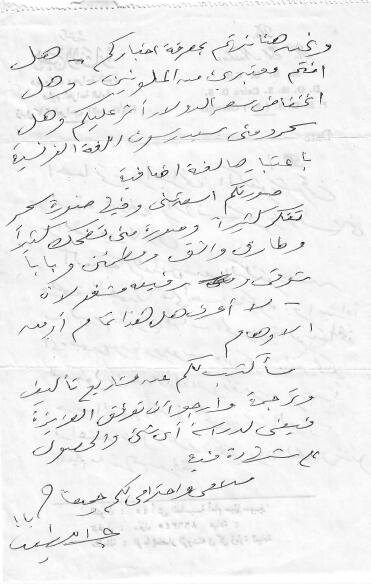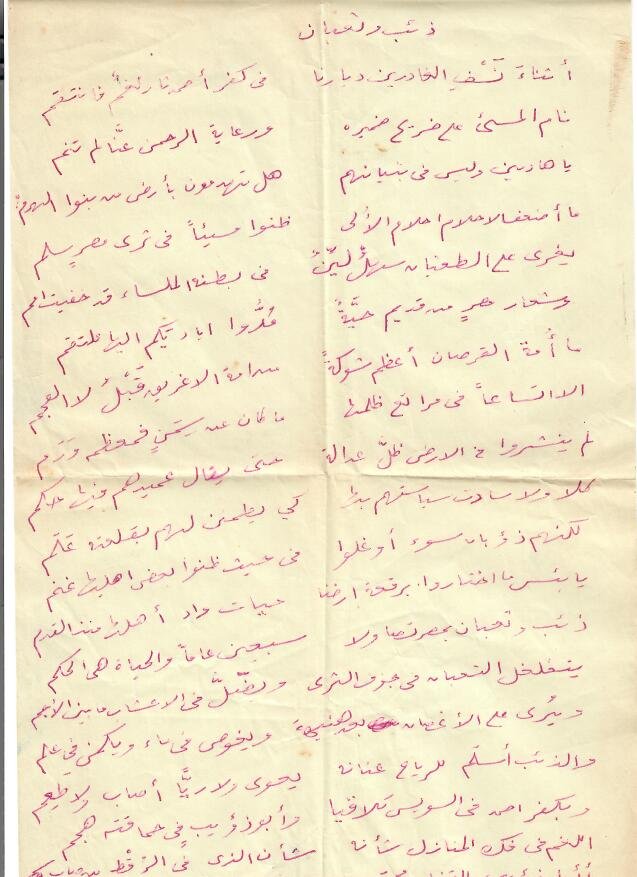Poetry and short stories
The following works of abdel latif have been collected and scanned. many details are unknown. Some dates are available. What has been found were Mostly in his daughter, Rafia’s, Library. However, some were found from the Egyptian archives, and some online in wikisource arabic.
collected poems published posthumously
These links below are scans of collections of Abdel Latif’s poetry that were published as two volumes posthumously in 1976 and 1978. Most of his poems were scattered between newspaper clippings, magazines, and many were found in his handwriting sent to friends and family and had never been published. After his death, Rafia worked with Ahmed Mostafa Hafez PhD, who was a mentee of Abdel Latif and a protege in his own right, to curate Abdel Latif’s poetry into two books. They worked together through cross-Atlantic correspondence for several years.
Collections of Poems by Abdel Latif ElNashar Volume I curated by Dr. Ahmed Mostafa Hafez, Ph.D. and Rafia ElNashar, Egyptian General Publishers 1976
Collections of Poems by Abdel Latif ElNashar Volume II curated by Dr. Ahmed Mostafa Hafez, Ph.D. and Rafia ElNashar, Egyptian General Publishers 1978
Mention is made of a set of Abdel Latif’s poetry titled “Pharaoh’s Heaven and Moses’ Fire.” It is not known by this website’s archivists if this set is a lost work or if the two posthumously published volumes were an attempt to recreate it.
Magazine Publications and Periodicals
The Al-Risala Weekly, an important literary magazine in Egypt, published at least 100 pieces by Abdel Latif. His works can be found in volumes from 1938 through 1951, two years before the publication closed.
Al-Risala Magazine
Article Several stories and poems from 1941
Poetry Several stories and poems from 1941
Story Several stories and poems from 1941
Entire Several stories and poems from 1939
Story Several stories and poems from 1939
Story Several stories and poems from 1938
Poetry Several stories and poems from 1937
List of approximately 100 pieces in Al-Risala from Wikisource Arabic
OTHER PUBLICATIONS
The Empty Heart, ElHilal Magazine, Cairo, Dec 1916
Unknown Lover, Ramses Magazine, Egypt, Dec 1916
A Commendation to King Albert, the Wounded Belgian, AlAhram Magazine 1934
The Rooster’s Crow, The New Magazine, Cairo, May 1939
Alexandria After the Crisis, AlRisala, June 1941 (about the German bombing of Alexandria during World War II)
Greetings for Poets, 5th Conference of Poetry in Alexandria 1963 Under the Patronage of the High Council Overseeing Arts and Literature
LITERARY criticism AND WRITINGS ABOUT ABDEL LATIF’S LIFE
In 1980, Farouk Ahmed El Meehy wrote a dissertation on the life of Abdel Latif ElNashar for his Masters thesis at Al-Azhar University Cairo, Department of Arabic Language entitled “Abdel Latif, His Life and Works” A pdf scan is available here in Part 1 and Part 2.
Dr. Ahmed Mostafa Hafez, the curator of his poetry, wrote an article about Abdel Latif in 1997 in Al-Azhar Magazine, Poet of Alexandria: Abdel Latif ElNashar.
An article appeared in Al-Arabi, ElNashar, Dean of Alexandria’s Poets, by Fouad Dawaris, in February 1982, Volume 279.
Personal letters and documents
A partial set of Abdel Latif’s documents and personal letters to his daughter and other family members were in Rafia’s possession. They provide an intimate look at his life and his love for his wife, daughter, and grandchildren. They are also a commentary on Egypt’s politics and society such as his letter to her sharing his thoughts following the 1967 Israeli bombing of Cairo.
Abdel Latif was curious about modern society. In this letter (circa 1971) addressed to his son-in-law, Dr. Mahmoud Shawky Taman when his daughter and her family had immigrated to the U.S. and were living in Iowa, Abdel Latif reflects on changes in Egyptian society noting that girls are now wearing trousers. He also informs that he discovered a new author, George Washington King, an American writer and poet who was from Iowa. He also discussed racism that he learned was in American society and puzzles as to why it exists.
A question that should be considered is how did Abdel Latif learn English to be a translator of the intricacies and innuendo to literature.
Here is an example of what appear to be notes of him teaching himself words and practicing versions of sentence translations.
This letter to his daughter of June 7, 1966, reveals that Abdel Latif’s use of aesthetic similes and poetic play was a part of his regular writing.
This poem, which appears to be written after the 1956 Egyptian Israeli war, is titled, “Wolves and Snakes.” It is among the few examples available of Abdel Latif’s poetry in handwriting. This dark poem laments that people do not want peace but instead are fed by greed.
In this December 24, 1966 poem written to his daughter Rafia, Abdel Latif evokes the Muslim Sufi scholar, Ibn Arabi of Andalusia, “Love is one thing that all religions, sects, and peoples believe in.” “Power and love equal justice, and that is how I am a Muslim.” Abdel Latif was perhaps an enigmatic combination of a Sufi, an existentialist and a leftist.
Maher Tawfik Sadiq, who considered himself a student of Abdel Latif, wrote this typed letter to him on November 6, 1958, asking him to critique the poem he had written in the letter.
In 1966, when his granddaughters, Sahar and Mona Taman, who were four and three years old, lived with him while their mother was in England with their father who was studying at the Royal College of Psychiatrists, Abdel Latif writes to Rafia who apparently was considering bringing them to her, that it would be a shame for the girls to lose the two years of their early education if they move to London.






















